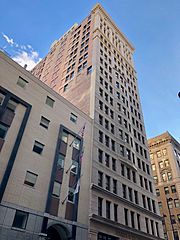- This page was last modified on 17 October 2025, at 10:18. Suggest an edit.
Fourth & Walnut Center facts for kids
| Fourth & Walnut Center | |
|---|---|
 |
|
| Former names | Clopay Building First National Bank Building |
| General information | |
| Type | Commercial offices |
| Architectural style | Chicago school |
| Location | 105 East 4th Street Cincinnati, Ohio |
| Coordinates | 39°06′00″N 84°30′39″W / 39.09998°N 84.51077°W |
| Completed | 1904 |
| Height | |
| Roof | 73 m (240 ft) |
| Technical details | |
| Floor count | 19 |
| Lifts/elevators | 7 |
| Design and construction | |
| Architect | D.H. Burnham & Company |
|
First National Bank Building
|
|
| NRHP reference No. | 100000570 |
| Added to NRHP | January 24, 2017 |
The Fourth & Walnut Center is a cool building in Cincinnati, Ohio. It used to be known by other names like the Clopay Building and the First National Bank Building. When it was finished in 1904, it was the tallest building in the entire state of Ohio for almost 10 years!
Discovering the Fourth & Walnut Center
This amazing building was designed by a famous architect named Daniel Burnham. His company, Burnham & Associates, completed the building in 1904. It stands tall at 73 meters (about 240 feet) and has 19 floors.
What is Chicago School Architecture?
The Fourth & Walnut Center was built in a style called the Chicago school. This style became popular in Chicago around the late 1800s. Buildings in this style often have:
- Strong, simple shapes
- Lots of windows, sometimes in big groups
- Steel frames inside, which allowed them to be built much taller
- Less fancy decoration compared to older buildings
Daniel Burnham was a key architect in this style. He helped create many of the first skyscrapers.
A Historic Landmark in Cincinnati
The building has been an important part of Cincinnati's skyline for over a century. In 2017, it was officially added to the National Register of Historic Places. This means it's recognized as a special place that's important to history. It's also a Cincinnati Local Historic Landmark.
The name "Clopay Building" was a mix of the words "clothing" and "paper." This shows that the building likely housed businesses related to those industries a long time ago. Today, it's still used for commercial offices.
